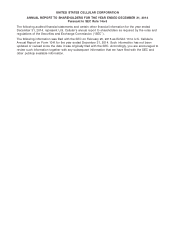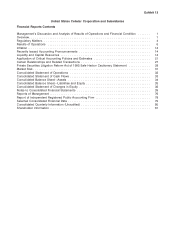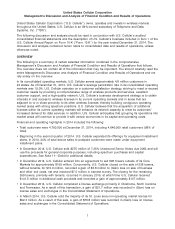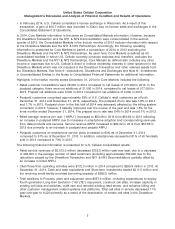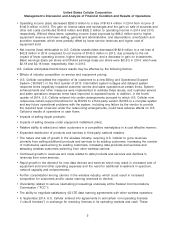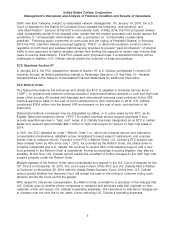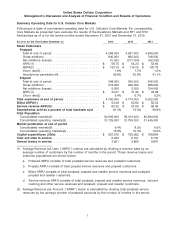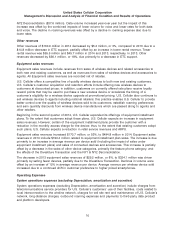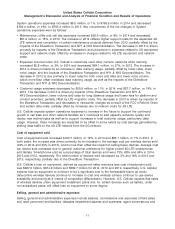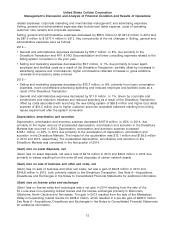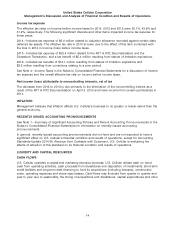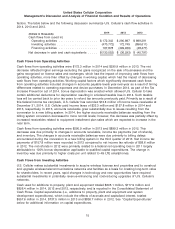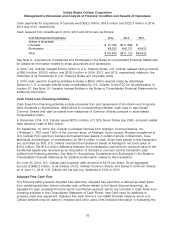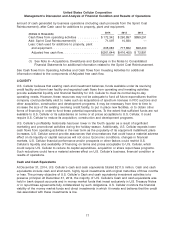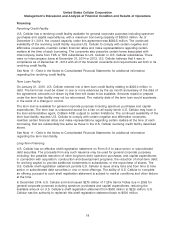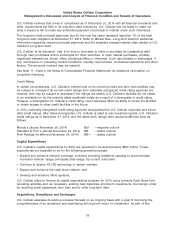US Cellular 2014 Annual Report Download - page 17
Download and view the complete annual report
Please find page 17 of the 2014 US Cellular annual report below. You can navigate through the pages in the report by either clicking on the pages listed below, or by using the keyword search tool below to find specific information within the annual report.United States Cellular Corporation
Management’s Discussion and Analysis of Financial Condition and Results of Operations
Operating Revenues
Service revenues
Service revenues consist primarily of: (i) charges for access, airtime, roaming, recovery of regulatory
costs and value added services, including data products and services, provided to U.S. Cellular’s retail
customers and to end users through third party resellers (‘‘retail service’’); (ii) charges to other wireless
carriers whose customers use U.S. Cellular’s wireless systems when roaming; and (iii) amounts received
from the Federal USF.
Retail service revenues
Retail service revenues decreased by $152.5 million, or 5%, to $3,013.0 million due primarily to a
decrease in U.S. Cellular’s average customer base (including the reductions caused by the Divestiture
Transaction and NY1 & NY2 Deconsolidation), partially offset by an increase in billed ARPU.
In 2013, Retail service revenues decreased by $382.5 million, or 11%, to $3,165.5 million due primarily to
a decrease in U.S. Cellular’s average customer base (including the reductions caused by the Divestiture
Transaction and NY1 & NY2 Deconsolidation) and a slight decrease in billed ARPU. In the fourth quarter
of 2013, U.S. Cellular issued loyalty reward points with a value of $43.5 million as a loyalty bonus in
recognition of the inconvenience experienced by customers during U.S. Cellular’s billing system
conversion in 2013. The value of the loyalty bonus reduced Operating revenues in the Consolidated
Statement of Operations and increased Customer deposits and deferred revenues in the Consolidated
Balance Sheet.
Billed ARPU increased to $53.49 in 2014 from $50.73 in 2013. This overall increase is due primarily to an
increase in postpaid ARPU to $56.75 in 2014 from $54.31 in 2013 and an increase in prepaid ARPU to
$34.07 in 2014 from $31.44 in 2013, reflecting an increase in smartphone penetration and corresponding
revenues from data products and services, partially offset by lower monthly service billings for customers
on equipment installment plans. Billed ARPU in 2013 was relatively flat compared to $50.81 in 2012. An
increase in smartphone adoption and corresponding revenues from data products and services drove
higher ARPU; however, this growth was offset by the special issuance of loyalty rewards points in the
fourth quarter of 2013, which negatively impacted billed ARPU for the year by $0.70.
U.S. Cellular expects continued pressure on retail service revenues in the foreseeable future due to
industry competition for customers and related effects on pricing of service plan offerings offset to some
degree by continued adoption of smartphones and data usage. In addition, beginning in the second
quarter of 2014, U.S. Cellular expanded its offerings of equipment installment plans. To the extent that
customers adopt these plans, U.S. Cellular expects an increase in equipment sales revenues. However,
certain of the equipment installment plans provide the customer with a reduction in the monthly access
charge for the device; thus, to the extent that existing customers adopt such plans, U.S. Cellular expects
a reduction in retail service revenues and ARPU.
Inbound roaming revenues
Inbound roaming revenues decreased by $39.1 million, or 15% in 2014 to $224.1 million. The decrease
was due in part to a $17.6 million impact related to the Divestiture Transaction and NY1 &
NY2 Deconsolidation recorded in 2013. The remaining decrease in the Core Markets was due to a
decrease in rates and a decline in voice volume, partially offset by higher data usage. U.S. Cellular
expects modest growth in data volume, declining voice volumes and declining rates which likely will
result in declining inbound roaming revenues in the near term. Both inbound and outbound roaming
rates are subject to periodic revision; further, U.S. Cellular is negotiating 4G LTE roaming rates with
several carriers which could materially affect roamer revenues and expenses going forward.
Inbound roaming revenues decreased by $85.5 million, or 25% in 2013 to $263.2 million. The decrease
was due primarily to lower rates ($47.9 million) and the impacts of the Divestiture Transaction and NY1 &
9


